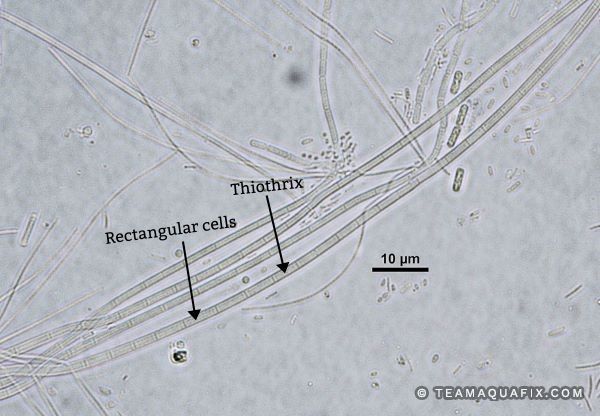
Thiothrix can cause bulking when present in high abundance.
To reduce the abundance of Thiothrix, we recommend increasing aeration to raise the oxidation/reduction potential in your wastewater plant. If increasing aeration is not possible, Aquafix recommends the addition of OxyFresh to help combat low dissolved oxygen levels. If you are having difficulties maintaining adequate D.O. levels, we recommend consulting with us to address potential issues with aeration or overloading.
Because wastewater issues and the cause behind filaments can be complex, we recommend our Filament ID and Microanalysis. This not only confirms organism ID, but looks at biological indicators, plant design, and incoming substrates to decode your unique process.
Thiothrix is a common bulking filament. It is categorized into two different filament groups, Thiothrix I and Thiothrix II. Thiothrix I is slightly wider (1.6-2.5 µm) than Thiothrix II (0.8-1.4 µm). Due their shared genus, these filaments are usually grouped together. Thiothrix prefers conditions with low levels of dissolved oxygen, incoming septic waste, nitrogen deficiency, and/or sulfur-reducing conditions. Thiothrix can be identified using 1000x magnification. These filaments have rectangular cells that regularly store sulfur granules. However, Thiothrix may not always have sulfur granules, making identification difficult. To circumvent this, Thiothrix can be forced to store sulfur granules by conducting an S test. This is done by exposing a sample to sodium sulfide for 10-15 minutes, allowing sulfur to be stored in granular form within the filaments to confirm identification. These granules can be viewed under 400x magnification using phase contrast. Thiothrix is a genus of filament species which includes Type 021N. It tends to be thicker than other Thiothrix forms and tends to have disk shaped, cells, rather than rectangular cells. Type 021N is separated out from the rest of the genus for identification and treatment purposes because it does not readily store sulfur like the rest of the filaments in this genus. Thiothrix stains Gram negative, however, it can occasionally contain Gram positive granules. If Thiothrix grows rapidly enough, rosettes are formed. Rosettes are when multiple filaments extend around the same center point, forming an asterisk-like shape.
Eikelboom, D.H. & van Buijsen, H.J.J. (1983). Microscopic sludge investigation manual.
Jenkins, D., Richard, M.G., & Daigger, G.T. (2004). Manual on the causes and control of activated sludge bulking,
foaming, and other solids separation problems (3rd ed). CRC Press LLC.

39041 RGE RD 283,
Red Deer County, AB T4E 0M2
Phone: 1-888-466-0031 |
Fax: 1-888-507-9716
To place an order, please fill out the required fields below and proceed to checkout. Ensure all information is accurate, and feel free to contact our support team if you have any questions or need assistance. Thank you for choosing us!